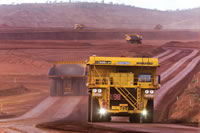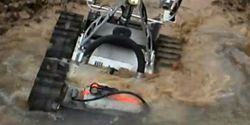Autonomous Underground Mining Vehicles Are a Thing Now
Depending on how tests of below-ground and above-ground equipment progress, multiple technologies could be incorporated into single vehicles to make them maximally adaptable to operator needs.
Mining 24 Hours a Day with Robots
Tom Simonite for MIT Technology Review: Each of these trucks is the size of a small two-story house. None has a driver or anyone else on board.
Mining company Rio Tinto has 73 of these titans hauling iron ore 24 hours a day at four mines in Australia’s Mars-red northwest corner. At this one, known as West Angelas, the vehicles work alongside robotic rock drilling rigs. The company is also upgrading the locomotives that haul ore hundreds of miles to port—the upgrades will allow the trains to drive themselves, and be loaded and unloaded automatically.
Rio Tinto intends its automated operations in Australia to preview a more efficient future for all of its mines—one that will also reduce the need for human miners. The rising capabilities and falling costs of robotics technology are allowing mining and oil companies to reimagine the dirty, dangerous business of getting resources out of the ground. Cont'd...
Gemini-Scout Mine Rescue Robot
Reliability, ability to travel across varied terrains, and accurate operation are essential elements for the drive system and camera controls on mining rescue robots.
Robots Explore Dangerous Mines with Novel Sensor Fusion Technology
The 3D Riegl scanning laser range finder and an Acumine 2D scanning millimeter wave radar were transported on Husky and used to record video footage and densely sampled data sets. The data is being submitted to the International Journal of Robotics Research to ensure that this insight and information is available to the robotics community.
Records 1 to 4 of 4
Featured Product

Oriental Motor USA - Ideal for AGV/AMR Applications
The BLV Series R Type brushless DC motor (BLDC motor) speed control system offers the design of motor and driver significantly reduced in size and weight, yet high-power, and contributes to the battery driven automation. The BLV Series R Type is compatible with the two interfaces of Modbus (RTU) and CANopen communication.




